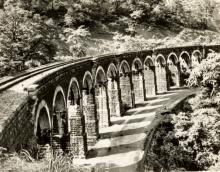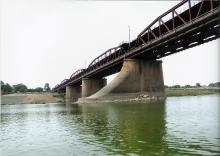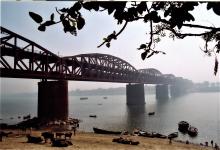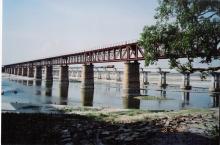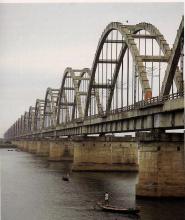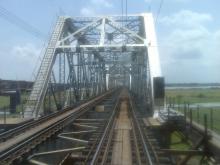The first rail line in India, between Bori Bunder in the erstwhile Bombay to the suburb of Thana (now Thane), became operational in 1853. The network expanded at a furious pace after this and by 1920, there were over 62,000 kilometres of rail lines in the then British India, which included the present Pakistan, Bangladesh and Burma. The engineers and labourers who built this impressive network faced many obstacles but the major challenge they faced was the fording of its many large rivers. Not only were the rivers much wider than rivers encountered in Britain and elsewhere in the world, they were also constantly shifting course, had a very significant seasonal variation in the flow of water and with centuries of accumulated silt in the alluvial soil it was hard to find rock or suitable strata on which to build bridge foundations. The early engineers were thus pioneers, great innovators, had remarkable perseverance and organisational skills. They built some of the largest and finest bridges in the world which, in many cases, are still in use more than a century and a half later. After Independence, that pioneering spirit continued and Indian engineers have been able to bridge the mighty Brahmaputra for the first time, build additional bridges across the Ganga and other large rivers, apart from replacing many of the older ones which had completed their design life. One of the most impressive bridges was recently the opened third bridge across the Brahmaputra near Dibrugarh in Assam. This is the longest rail bridge in the country. A number of very impressive bridges and viaducts have also been built on the Konkan Railway. Perhaps the most challenging bridge construction being undertaken in recent times is the bridge over the Chenab on the line from Jammu to Srinagar. This steel arch bridge will be the tallest in terms of height from the river level to the centre of the arch at 359 metres is much taller than the height of the Eiffel Tower.
A number of designs were adopted for these railway bridges. One of the earliest was the time tested Arch Bridge, which had been mastered by the Romans. The arch bridge transfers the vertical weight of the bridge and the load on it to a horizontal thrust along the curve of the arch, and finally to the abutments on both sides. The early arch bridges included the Dhapoorie Viaduct, on the Great Indian Peninsula Railway (GIPr) between Bombay and Thana, which figures so prominently in the photograph of the first train in India. On the East Indian Railway (EIR), on the line from Howrah to Delhi, the bridge over the Adjai and Mor Rivers in South Birbhum district consisted of 32 and 24 arches respectively with each arch of 50 feet. These had been completed by 1859. At the other end of the route to Delhi, at Ghaziabad over the Hindun River, was an arched brick bridge, still operational, with six openings of 70 feet each.
One of the factors which became a constraint in the construction of arch bridges was the limited capacity to manufacture bricks for the bridges and non-availability of suitable clay for brick making near the bridge sites. Therefore, engineers began to design bridges early with steel girders ordered from Britain. However, arch bridges continued to be built even at the end of the 19th and beginning of the 20th Century on the Grand Chord and elsewhere in India. Some of the most attractive arch bridges include the Hasdeo Bridge between Manendragarh and Chirimiri, the Dara Viaduct south of Kota, and the Meter Gauge viaduct on the Quilon to Tenkasi line. A remarkable use of the arch is in the Gallery Arch bridges on the Narrow Gauge line from Kalka to Shimla, where tier on tier of arches were built in the style of the ancient roman aqueducts, to carry the line from one spur to the next.
The Screw Pile bridge was another type of bridge the early engineers adopted, particularly while bridging estuaries, backwaters and where the current was not severe. On the erstwhile Bombay Baroda & Central India (BB&CI) Railway it was the type of bridge built across all major creeks and rivers between Mumbai and Ahmedabad, including Vasai Creek, Tapti, Narmada and Mahi Rivers. The piers would consist of two or more cast iron cylinders that would be screwed down to an appropriate depth below the silt, mud and sand where a stratum of hard clay was found. For example, the original Vasai Creek bridge, opened in 1864, consisted of piers of three piles 2 feet 6 inches in diameter with foundations 20 to 72 feet below bed level over which double spans of 60 feet deck Warren girders were laid. Later, to strengthen the bridge, two additional piles were added. In the second Vasai Creek bridge, opened in 1927, each pier consisted of six braced cast iron piles. Each pile was spaced 9 feet apart consisting of 5 piles with a diameter of 3 feet and the fender pile 2 feet 6 inches in diameter. The screwing down methodology of the piles was interesting. In case of the first Vasai Creek, a capstan was fixed to the pile top with radiating poles 40 feet long to which 16 oxen were harnessed and they walked round in a circle on rafts that had been moored in the appropriate position. By the time the second Vasai Creek was built, the pile driving was done with electrically operated capstans. The screw pile design had its limitations and bridges of this design over the Tapti and Narmada were replaced after a relatively short life span. Finally, Indian Railways as a policy, decided to replace all bridges of this type after an accident on July 21, 2001, when the bridge over Kadalundi River in Kerala gave way and over 50 lives were lost.
The evolution of the well foundation adopted and pioneered by the early railway bridge designers and builders has been a major contribution to large bridge construction in the country. In view of the difficult subsoil conditions of the foundation bed, open foundations could not be applied in India in most cases. The advantages of the well foundation were quickly realized. This design was indigenous to India and had been adopted in early bridge and building construction apart from the construction of ordinary wells for drawing water. The well foundation involved the sinking of cylinders or wells of brickwork to considerable depths through the sand until clay or rock was reached. Piers were built over foundations of a single well or a cluster of wells. For example, in case of the bridge over the Yamuna at Allahabad, each pier is founded over a cluster of 12 wells resting on strong iron curbs. In many cases, even in the early years, the wells were strengthened with iron work consisting of both vertical and horizontal members. Once the wells were founded they were usually filled with sand and capped. The well foundation over time has become the most popular method of founding bridges in India particularly where scour and bearing capacity are considerations. They have the capacity to efficiently take on very large vertical and horizontal loads. It is only relatively recently that bridge engineers have begun to consider pile foundations as an alternative methodology based on time and cost considerations. There have also been technological improvements over time with the use of pneumatic systems.
In the early days, Bridge engineers in sinking well foundations often did encounter difficulties, to overcome which, they had to innovate and often found novel solutions. For example, on the bridge over the Yamuna at Allahabad, by August 1862 all the wells had been more or less completed except the well for pier No. 13. As this well had created problems, a coffer dam had to be built to overcome the difficulty. The water level was lowered by 9 feet, the well was dug out and a flooring of ashlar and stones was laid. On this an arch was sprung of stone masonry, 52 feet in diameter over which the pier was built. The pier today, because of its shape, is known as the elephant’s foot and is still distinct from all others in the bridge.
The super-structure normally consisted of iron or steel girders. In the early days ‘Lattice’ girders were sometimes used, e.g. the original girders on the Yamuna Bridge at Delhi, the RMR built Bridge over the Yamuna at Agra and Bridges on the Beas and Sutlej Rivers on the line from Delhi to Lahore, are of lattice design. On the Allahabad Yamuna Bridge in 1913, down line girders were provided to facilitate double line working which were ‘Pony deck Span hog backed N trusses’, with railway on top and roadway underneath for cart traffic. The second bridge over the Narmada at Bharuch, known as the Golden Gate Bridge, has girders described as ‘Whipple Murphy Truss’ and still operates as a road bridge. More common were the Warren, Howe and Pratt Truss designs named after 19th Century engineers who patented them. Subsequent terminology describes girders by their shape e.g. ‘N’ or ‘K’ Trusses or as Open Web Girders. However, post Independence, particularly in the last three decades, there has been much greater use of pre-stressed concrete (PSC) slab girders and many of the new bridges built over major rivers either as replacement of earlier bridges or new bridges have been with Pre-Stressed Concrete (PSC) slab girders. The longest bridge in India today is the Vallarpadam Bridge which has 236 PSC girders, 198 of which are 40 metre long. The launching of girders, whether steel or PSC slabs, is a very exacting exercise and several alternative methodologies are adopted depending upon size of span, site conditions and accessibility of the site. These include use of cranes or derricks, end launching including the cantilever method, side slewing, use of trestles or in case of open web girders with the help of a launching nose.
Integral to the construction and maintenance of bridges, particularly in Northern and Eastern India, is the need for constant river training and protection works. There are a number of bridges in the sub-montane, quasi-alluvial and alluvial reaches of major rivers. With a view to protect the bridge, ensure the river flows through a well defined channel and check the effects of meandering, various types of river training works have had to be carried out. These include construction of Guide Bunds, Groynes as well as Marginal and Closure Bunds. For example, on the uppermost railway bridge over the Ganga at Balawali, where the first bridge was opened in 1887, river training works have been a recurring requirement. There are left and right guide bunds running parallel to the bank for training the river. The moles of these guide bunds after the monsoons have been frequently damaged and have required regular repair. In the case of the new Brahmaputra Bridge at Dibrugarh, currently under construction, Guide Bunds have been built on the North and South Bank 2 kms. and 2.7 kms. long respectively, apart from about 16 kms. long dykes on each bank.
Railway Bridges are some of the ‘Mega Structures’ that have been created by Railway Engineers over the last hundred and sixty five years. Prior to Independence, there were the massive bridges over the Ganga at Balawali, Garhmukhteshwar, Rajghat, Kanpur, Allahabad and Varanasi. Similarly, there were a number of bridges over the Yamuna near Sarsawa, Delhi, Agra, Hamirpur and Allahabad. In 1900, as part of the Grand Chord, a bridge across the Sone River near Dehri-on-Sone was constructed, what was then the second longest bridge (10,052 feet/ 3,064 meters) in the world after the Tay Bridge in Britain. Across the Hooghly at Kolkata, EIR built two more noteworthy bridges known as the Jubilee (1887) and Wellington (Vivekanada) (1932) Bridges. The EIR engineers in the 1850’s had the vision and foresight to build the substructure of most of their bridges for double line and many of them continue to serve the system today despite the increase in axle loads. There were other remarkable bridges built across the Narmada and Tapti both on the BB&CI and GIP Railways, the Mahanadi, Godavari and Kistna on the East Coast line and Palar, Cauvery and Pamban bridges in Southern India.
Post Independence, the Saraighat (1963) and Naranarayan Setu (1998) are mega structures across the Brahmaputra as are the second and third bridges across the Godavari at Rajahmundry. New, replacement or additional bridges have been constructed across the Ganga at Balawali, Delhi, and Allahabad in the north, at Mokama and Farakka in the East, Vasai Creek in the West, and in the South, a new Broad Gauge bridge across the Coleroon, conversion from MG to BG of the Pamban Bridge and the mega Vallarpadam Bridge. The longest bridge in India is the third Brahmaputra Bridge at Dibrugarh. The nation is eagerly awaiting its tallest bridge over the Chenab in Kashmir.
In creating these masterpieces, engineers and construction workers have toiled tirelessly, little realizing their tremendous contribution in building India’s massive rail network that integrates diverse regions, people and cultures into a formidable and united nation. By the time the British left India, the rail network had reached almost every corner of the nation. The notable exceptions were the West coast and a link to the Kashmir Valley. The primary reason for this was the difficulty in building the large number of bridges and viaducts (and tunnels) that would be required in both these regions. The Konkan line with about 2000 bridges has taken care of the West coast, while the link to the Kashmir Valley with over 750 bridges should be completed in the near future.

